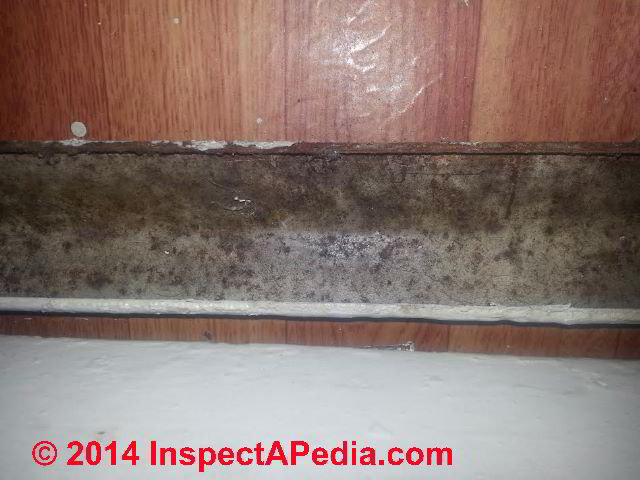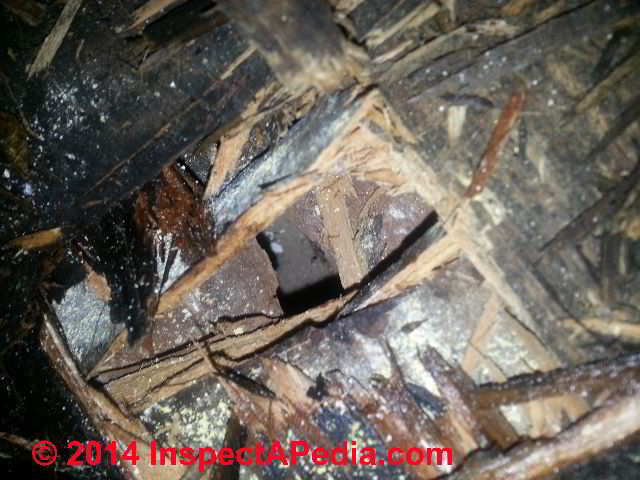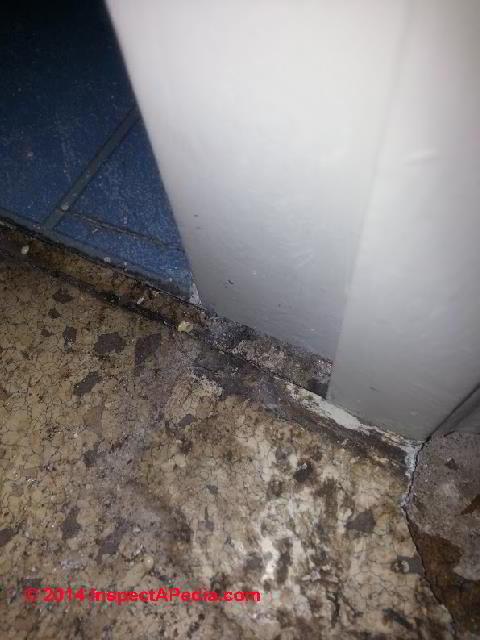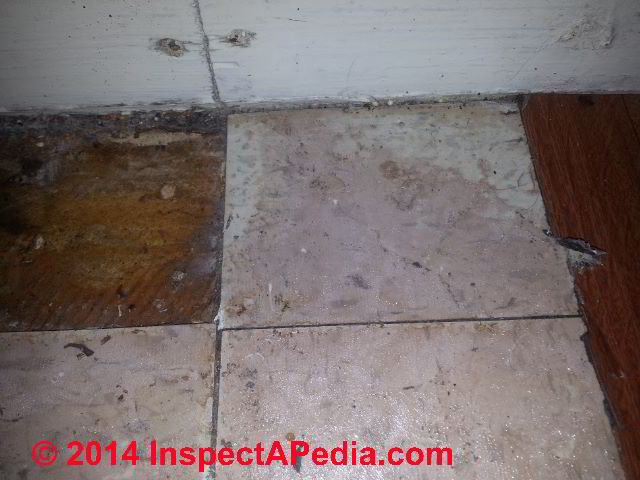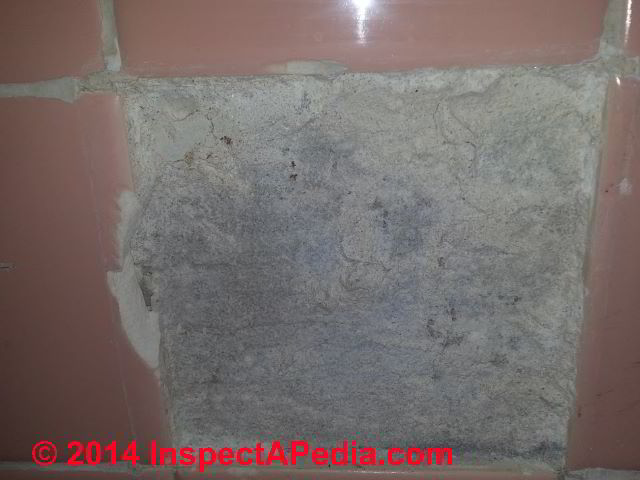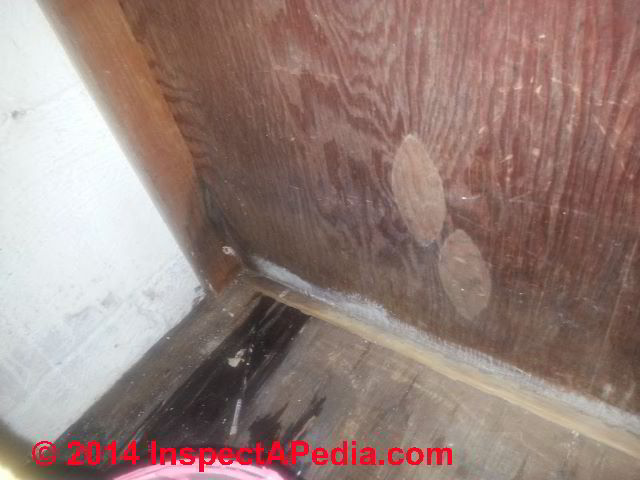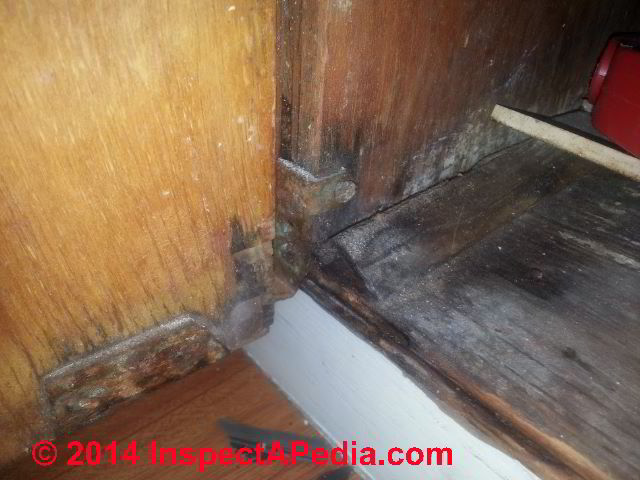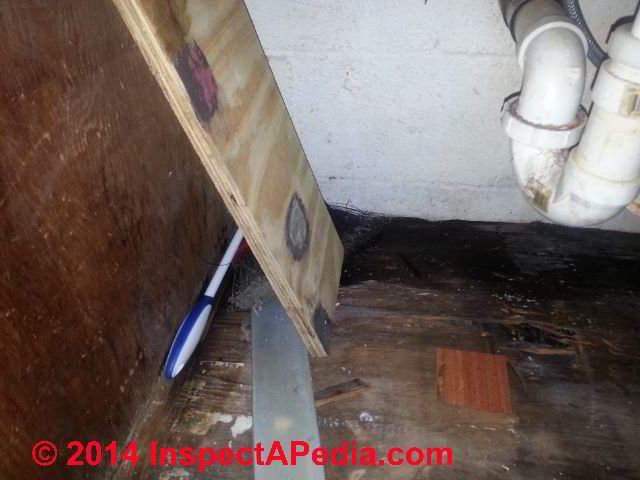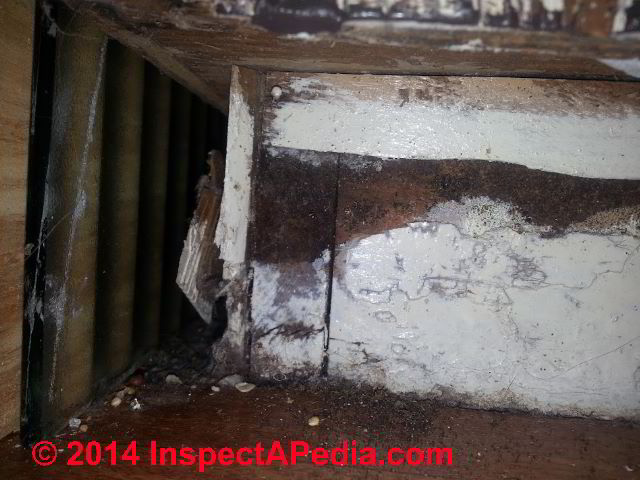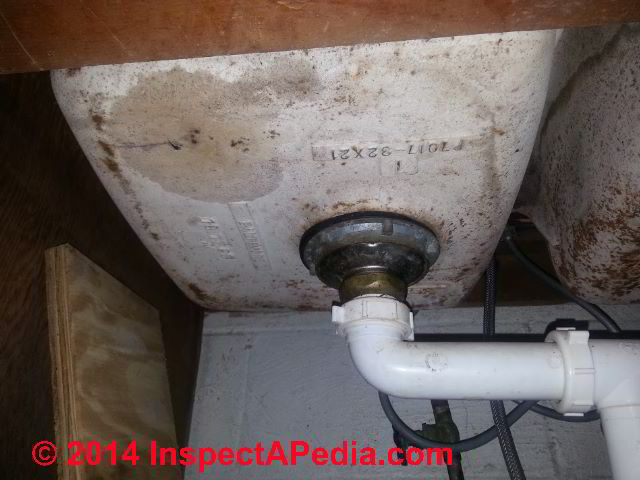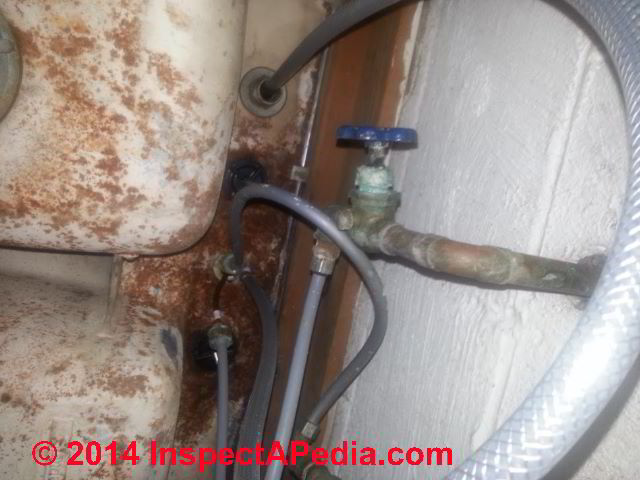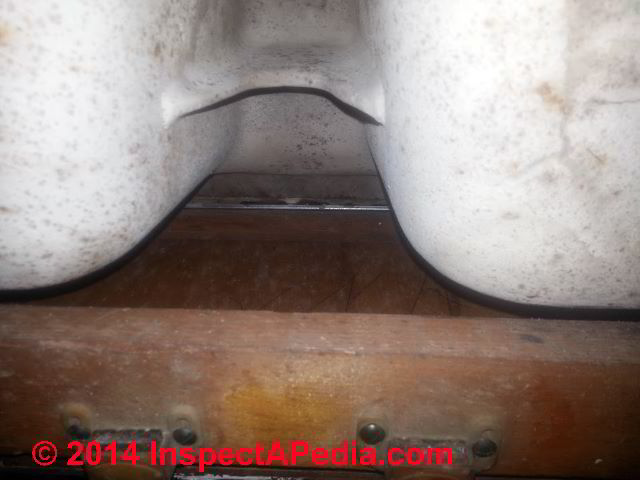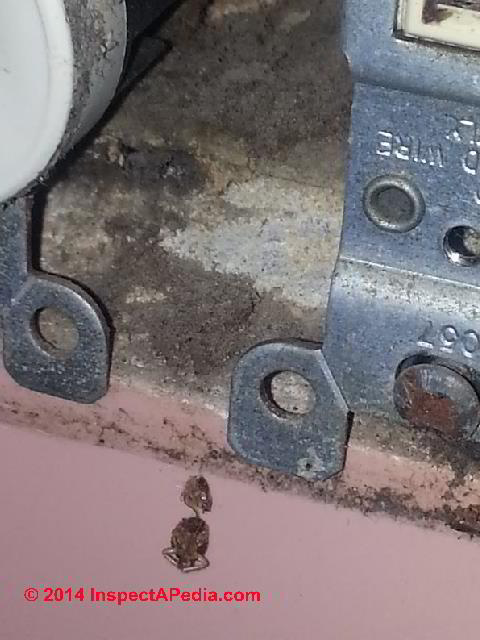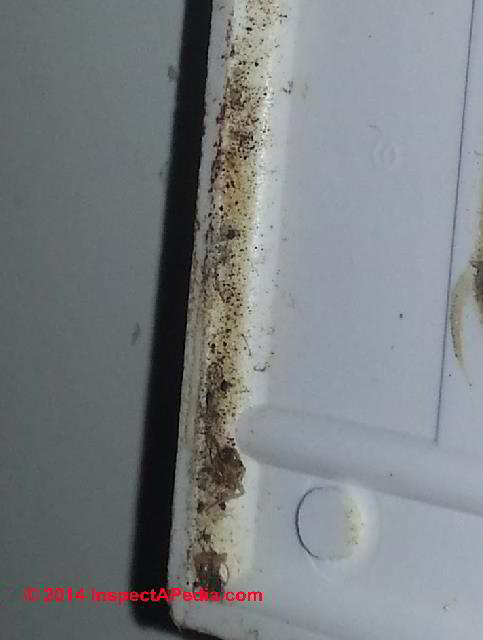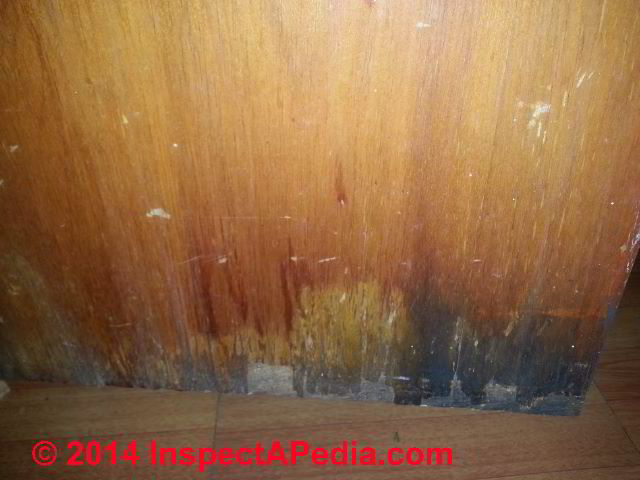 Moldy rental apartment or house testing procedures
Moldy rental apartment or house testing procedures
& advice for tenants
- POST a QUESTION or COMMENT about mold test procedures for a rental apartment or home suspected of having mold contamination or mold-related illness hazards
Mold testing & inspection advice for renters.
Page top photo: water stains on wood paneling tell us there's a risk of more serious mold contamination on the hidden side of the paneling and on drywall behind that and in the wall cavity as well. The floor cavity also needs to be inspected.
This article describes a tenant's efforts to terminate a lease, move out of what is believed an unsafe, moldy apartment, and to obtain supporting tests and documentation for that purpose.
InspectAPedia tolerates no conflicts of interest. We have no relationship with advertisers, products, or services discussed at this website.
- Daniel Friedman, Publisher/Editor/Author - See WHO ARE WE?
Mold Inspection, Test, Cleaning Advice for Renters
The exchange documented below illustrates a conversation between the building investigator (and this editor) and the tenant of a city apartment suspected of having unsafe moldy conditions.
We spoke first by telephone as the tenant described suspected building-related illness, concern for the health of small children, and what she was convinced was an unsafe environment. In the process of seeking to terminate her lease the tenant was already in court in a tenant-landlord dispute.
Photo at left: this picture does not show a large area of mold contamination but it does show evidence of a history of building leaks or water entry - conditions that increase the risk of a hidden mold reservoir. - Ed.
[Click to enlarge any image]
Tenant [in Italics]: Thank you for your help. Do you know what doctor I need to see for mold, and what mold testing needs to be done? Here are some pictures.
With the warning that no examination of photographs can substitute for an expert inspection of a property, that the photo-examiner can only look where the photographer pointed the camera, that other important evidence may be present but not observed by the photographer, but finally, that useful information can indeed be gleaned from photographs we comment on images provided by the reader.
Photo at above left: this is the rusty under-side of a heating baseboard top vent control. There is probably dust and debris on this surface and there could be mold growth if mold is growing on organic debris and dust or on paint. But this is component is not likely to form a significant mold reservoir in the building. Rather it is an indication of building conditions and age. - Ed.
Photo at above right: if this is a photograph of a floor in an area where people could walk, it indicates serious water damage, rot, and unsafe conditions. In any building location this indicates a history of leaks and absence of maintenance and / or repairs. - Ed.
The lawyer who gave me the information was one that offered 30 minutes free consultation, I will have to paid if I need more information.
Photos above: show damaged flooring that by pattern and apparent age may contain asbestos - renovators should beware of disturbing this material before determining if it is hazardous.
Intact and not subject to abrasion, grinding, etc. I am doubtful that the flooring, even if asbestos-containing, would be releasing measurable levels of asbestos into the air.
Details are
at ASBESTOS FLOORING HAZARD REDUCTION. - Ed.
The photographs below show other floor tiles in poor condition including broken fragments on whose under-side there might be mold growth - though from the photos alone I cannot know for sure.
Loose floor tiles may themselves be another indicator of the history of wet floors or leaks in this building.
I [will] be honest with you.
Everything is money, and I don't have.
I'm a single mother trying to protect my kids, I do have a letter from the city code inspector. the health department didn't help they said is not bad with out testing and they said is cosmetic and is not danger,
I'm not a professional and I know that's not good - you even can see the smoke or gas coming under cabinets.
Photos above and below: show mold in tile grout - a trivial condition and not one that alone would be expected to be a health concern.
This is a housekeeping and maintenance task, as is the missing bath wall tile at above right.
Watch out: These photographs are a common example of the ease with which a consumer can focus attention on unimportant but visually ugly conditions without recognizing that there may be important and more hazardous conditions in the same building. - Ed.
They all cover their back, this is negligent from their part. and the system always make things look complicated, you mention in the phone that you can help me with some test, a question can I test the section under the sink, ones I have the test, that I have to send the back right way or can I send the test monday. Thank you for your help. D.C. 2/25/2014
Photographs above: show missing covers on a heating baseboard (above left) - a hazard if someone's bare foot could come in contact with sharp edges
and what appears to be urethane foam spray insulation at the the penetration of a heating pipe, along with some corrosion on the copper heating line and debris on the floor.
I cannot recognize a problematic mold growth in these photos but caution that depending on age the flooring may contain asbestos - discussed above. - Ed.
Reply: Mold Doctors & Evidence of mold contamination in the photographs
If you are not sure how to decide if you or your family need to see a doctor who is expert in mold-related illness, check first with your own family doctor and perhaps also
see MOLD DOCTOR NEEDED ?
Contact information for finding a physician who has expertise in environmental medicine and mold-related illness is found
at MOLD DOCTORS - ENVIRONMENTAL MEDICINE .
The two photographs below look like the interior of a wooden cabinet. We can see dark areas almost certainly marking leak stains as well as white deposits that are most-likely mold growth on those surfaces. The photographs are not sufficient to determine that this is a large (actionable) 30-sq-ft. area of mold growth.
Watch out: There is risk of a larger hidden mold problem here. Quite often when we find leaks into or behind cabinets in kitchens or bathrooms, the more problematic mold growth is hidden on the under-sides and backs of those components - an area not visible unless cabinets are actually removed.
This occurs in part because the hidden surfaces of cabinets are by custom very often left un-finished: common building molds grow more readily on raw wood surfaces than on the same wood species if it has been sealed.
(Harmless mildew, a subset of molds consisting of two genera/species and often claimed to be present in buildings in fact grows only on living plants - there is no mildew on building surfaces, unless the building surfaces consist of living plants - like grape leaves.)
Details are at BATHROOM MOLD REMOVAL / PREVENTION and
at HIDDEN MOLD, HOW TO FIND. More mold-contaminated cabinets can be seen
Also see BROWN HAIRY BATHROOM MOLD for a Q&A on the harmfulness of "hairy brown mold" found in a bathroom.
The 94 photos you sent include evidence of a history of building leaks, insects (also a source of allergens and asthma aggravators), and some individually small (in the photos) areas of mold on surfaces. Excepting wooden cabinet interiors where there were large areas of white deposits that may be a mold reservoir, I could not see large (more than 30 sq.ft.) areas of mold contamination in these pictures.
Watch out: However I emphasize that when photographs show a history of building leaks and limited or poor maintenance (or poor housekeeping if mere cleaning was required), there is a risk of a more problematic hidden mold reservoir.
The level of actual hidden mold risk depends on the building leak history, building materials that have gotten wet, and other factors.
Above left we see a small area of mold growth on a concrete block wall below a sink.
And above we see that the white plastic sink trap has been leaking and that the sink cabinet bottom is water-damaged - creating also a risk of hidden mold beneath and on the sides of this cabinetry.
If inspecting further one would expect to find some fungal growth on the wood surfaces inside the cabinet and on the under-side of its bottom, possibly on the cabinet sides exterior as well.
At above left we see what looks like a cabinet baseboard that shows evidence of a history of leaks and also evidence that maintenance has consisted of painting over dirt and debris.
At above right we see a cast iron sink with some rust stains - there may be some fungal growth in the paint or in organic dust on the sink underside but this would not itself constitute a large area of mold.
At above left we see rust around the sink faucet mount (photo center) - a probable long-standing leak point
Above the light colored stains on the cabinet wood frame look like mold growth.
Watch out: Given the rust damage, leak history, and damaged cabinet base, cleaning and repair of this sink and cabinet base may cost more than simply removing and replacing the entire assembly.
In the two photographs above and just below we see insect bodies and debris at above right that may include a trivial area of mold growth. When discussing occupant health concerns with your doctor it would be reasonable to note that there may have been exposure to both airborne mold spores (of unidentified genera/species) and of insect fragments and debris.
Remember to Focus on Priorities of Attention When Worried about a Mold-Contaminated Apartment or Home
Probably the best one can do in your situation is to keep focused on what are the top priority things to do to keep yourself and your family safe and healthy.
Mold and other building-related illnesses can sometimes be serious, especially for people with asthma, or who are elderly, sick, immune-impaired, or infant. Small amounts of mold in a building (less than 30 sq.ft.) are not something to panic about. Large moldy areas are more risky and merit professional cleaning.
Failing to wear a seat belt or falling down the stairs, or smoking, are statistically greater risks to people in general.
If you have to move, do what you can to launder clothing and bedding and to clean visibly dusty or dirty stuff you are taking along.
Renter Advice: how to collect indoor mold test samples for laboratory analysis: easy, low-cost, reliable
If it will help you to have some samples tested I will do that pro-bono. But we need to understand why one would test for mold in the first place. Generally we do not need to test mold or to identify mold in order to plan a building clean-up. If there is a large area of non-cosmetic mold (which is usually the case) it needs to be removed and the cause for its growth fixed. Knowing the genera or species of mold does not change the clean-up plan.
There are however reasons to test or identify mold in some circumstances, including legal disputes that require (or attorneys and judges demand) technical evidence that a material is harmful mold, as well as
other MOLD TEST REASONS.
Also see MOLD TEST vs. PROBLEM DIAGNOSIS
For this specific case we agreed to process a small number of indoor surface or dust samples at no charge.
Watch out: note to other readers: do not send us mold samples, money, or anything else by mail without prior email or telephone agreement.
Follow the instructions at MOLD TEST KITS for using simple clear Scotch™ Tape and Ziplok™ type freezer bags to collect and mail surface samples of suspected mold or building dust for lab examination. The test procedure is simple and easy and does not require special education.
What does require some thought, as I explain below, is choosing the sample location and documenting what was tested.
Technical note on mold test accuracy and test precision
In my experience and professional opinion, strategically collected surface samples from a building can form the most reliable indicator of whether or not there is mold contamination.
Using air testing or culture testing not only require expertise in equipment handling, they are less reliable as tests because using an air test it is very easy to either obtain a false negative (indicating there is not a mold problem when in fact there is one) while using a culture or swab test it is very easy for a mold species that was not prevalent in the environment to grow on culture while important mold contaminants may not grow on that same culture.
Details are at ACCURACY OF AIR TESTS for MOLD.
An effective mold test and report should indicate whether or not the surface tested contains potentially harmful mold characteristic of a moldy environment. The test result may indicate this by noting what particles are dominant or most frequent in the sample.
A "mold count" is not necessary and can be misleading.
While lawyers and judges may like mold reports that give a score or number to the result, those numbers are at risk of being fundamentally very inaccurate.
Watch out: Simply waving a notebook, walking through a room, or turning a fan on or off during mold air testing will change the level of airborne particles by several orders of magnitude or more.
Details are at ACCURACY vs PRECISION of MEASUREMENTS
Where to Collect Mold Test Samples
Collect your samples from surfaces that you believe represent the largest areas of mold contamination in the building. For your own presentation, if you need to do so in court, include photographs showing a large-area view of the mold problem being examined, close-ups of your tape being pressed into that surface, with a magic-marker number written on the tape that corresponds to the sample you will send me.
Include your own made-up chain of custody form or use this one CHAIN of CUSTODY FORM - Multiple Sample - Printer Friendly - that documents: Your name and contact information The property address Date and time samples were collected The location of each sample point (e.g. kitchen cabinet exterior door; kitchen cabinet interior surface)
Look at each tape sample when you remove it from the test surface. If you don't see anything on it, while there may still be particles there, it's not a great sample. If you can see some mold or debris on the tape, that's probably a good sample.
Response to challenges of occupant-collected mold test samples
If you are in a dispute with the landlord, their attorney may argue that you are not a mold expert.
You can answer that just about anybody can identify what mold looks like on a building surface, and even if they are mistaken, the lab can at least indicate whether the surface was in fact moldy or not.
As long as the tested surface is by visible inspection representative of the suspected moldy area, that's a reasonable test.
See MOLD APPEARANCE - WHAT MOLD LOOKS LIKE
Put another way, the accuracy of surface testing to confirm a mold contamination problem in a building, or to study dust that settled in a building to look for high levels of harmful particles, depends almost entirely on where the sample was taken.
An attorney should also question whether or not the mold tests samples you collected are really from the apartment or home in question, and whether or not they accurately represent the conditions in the home. For these reasons, inspecting and testing by an independent, unbiased expert would be preferred.
But many tenants cannot afford the cost of a competent inspector. Having a witness, taking photographs of the test locations showing how the test area represents the apartment or home conditions in a large area, and documenting where, when, and how samples are collected should be enough to provide information that a court can decide are acceptable - or not.
...
...
Continue reading at TENANT HELP for MOLDY RENTAL where we give general advice for tenants in communicating with landlords about a suspected or known moldy environment in a rental apartment or home. or select a topic from the closely-related articles below, or see the complete ARTICLE INDEX.
Or see TENANT LANDLORD MOLD DISPUTE FAQs, diagnostic questions & answers posted originally at this page.
Or see these
Recommended Articles
- HEALTH DEPARTMENT HELP for RENTERS
- MOLD ACTION ADVICE for RENTERS
- RENTERS & TENANTS ADVICE for UNSAFE or UNHEALTHY HOME
- TENANT HELP for MOLDY RENTAL
- UNSAFE ENVIRONMENT, CAN'T LEAVE - what to do
Suggested citation for this web page
TENANT LANDLORD MOLD DISPUTE at InspectApedia.com - online encyclopedia of building & environmental inspection, testing, diagnosis, repair, & problem prevention advice.
Or see this
INDEX to RELATED ARTICLES: ARTICLE INDEX to MOLD CONTAMINATION & REMEDIATION
Or use the SEARCH BOX found below to Ask a Question or Search InspectApedia
Ask a Question or Search InspectApedia
Try the search box just below, or if you prefer, post a question or comment in the Comments box below and we will respond promptly.
Search the InspectApedia website
Note: appearance of your Comment below may be delayed: if your comment contains an image, photograph, web link, or text that looks to the software as if it might be a web link, your posting will appear after it has been approved by a moderator. Apologies for the delay.
Only one image can be added per comment but you can post as many comments, and therefore images, as you like.
You will not receive a notification when a response to your question has been posted.
Please bookmark this page to make it easy for you to check back for our response.
IF above you see "Comment Form is loading comments..." then COMMENT BOX - countable.ca / bawkbox.com IS NOT WORKING.
In any case you are welcome to send an email directly to us at InspectApedia.com at editor@inspectApedia.com
We'll reply to you directly. Please help us help you by noting, in your email, the URL of the InspectApedia page where you wanted to comment.
Citations & References
In addition to any citations in the article above, a full list is available on request.
- In addition to citations & references found in this article, see the research citations given at the end of the related articles found at our suggested
CONTINUE READING or RECOMMENDED ARTICLES.
- Carson, Dunlop & Associates Ltd., 120 Carlton Street Suite 407, Toronto ON M5A 4K2. Tel: (416) 964-9415 1-800-268-7070 Email: info@carsondunlop.com. Alan Carson is a past president of ASHI, the American Society of Home Inspectors.
Thanks to Alan Carson and Bob Dunlop, for permission for InspectAPedia to use text excerpts from The HOME REFERENCE BOOK - the Encyclopedia of Homes and to use illustrations from The ILLUSTRATED HOME .
Carson Dunlop Associates provides extensive home inspection education and report writing material. In gratitude we provide links to tsome Carson Dunlop Associates products and services.



